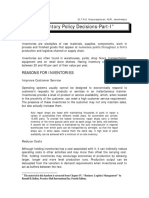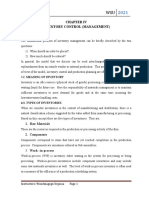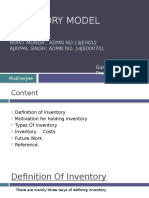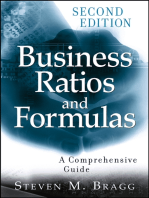0 ratings0% found this document useful (0 votes)
10 viewsChapter 13
Chapter 13
Uploaded by
brojan melanieThe document discusses inventory management concepts including reasons for holding inventory, requirements for effective management, associated costs, RFID technology benefits and risks, adjusting for industry differences, ABC classification, EOQ model assumptions and limitations, the purpose of safety stock, and how service level relates to safety stock amounts.
Copyright:
© All Rights Reserved
Available Formats
Download as DOCX, PDF, TXT or read online from Scribd
Chapter 13
Chapter 13
Uploaded by
brojan melanie0 ratings0% found this document useful (0 votes)
10 views2 pagesThe document discusses inventory management concepts including reasons for holding inventory, requirements for effective management, associated costs, RFID technology benefits and risks, adjusting for industry differences, ABC classification, EOQ model assumptions and limitations, the purpose of safety stock, and how service level relates to safety stock amounts.
Original Title
chapter 13
Copyright
© © All Rights Reserved
Available Formats
DOCX, PDF, TXT or read online from Scribd
Share this document
Did you find this document useful?
Is this content inappropriate?
The document discusses inventory management concepts including reasons for holding inventory, requirements for effective management, associated costs, RFID technology benefits and risks, adjusting for industry differences, ABC classification, EOQ model assumptions and limitations, the purpose of safety stock, and how service level relates to safety stock amounts.
Copyright:
© All Rights Reserved
Available Formats
Download as DOCX, PDF, TXT or read online from Scribd
Download as docx, pdf, or txt
0 ratings0% found this document useful (0 votes)
10 views2 pagesChapter 13
Chapter 13
Uploaded by
brojan melanieThe document discusses inventory management concepts including reasons for holding inventory, requirements for effective management, associated costs, RFID technology benefits and risks, adjusting for industry differences, ABC classification, EOQ model assumptions and limitations, the purpose of safety stock, and how service level relates to safety stock amounts.
Copyright:
© All Rights Reserved
Available Formats
Download as DOCX, PDF, TXT or read online from Scribd
Download as docx, pdf, or txt
You are on page 1of 2
1. What are the primary reasons for holding inventory?
- To meet anticipated customer demand.
- To smooth production requirements.
- To decouple operations.
- To reduce the risk of stockouts.
- To take advantage of order cycles.
- To hedge against price increases.
- To permit operations.
- To take advantage of quantity discounts.
2. What are the requirements for effective inventory management?
A system to keep track of the inventory on hand and on order.
A reliable forecast of demand that includes an indication of possible forecast error.
Knowledge of lead times and lead time variability.
Reasonable estimates of inventory holding costs, ordering costs, and shortage costs.
A classification system for inventory items.
3. Briefly describe each of the costs associated with inventory.
Purchase cost - is the amount paid to a vendor or supplier to buy the inventory. It is
typically the larges of all inventory costs.
Holding, or carrying costs - are the cost to carry an item in inventory for a length of time,
usually a year.
Ordering costs - are the costs of ordering and receiving inventory.
Setup costs - the costs involved in preparing equipment for a job.
Shortage costs – costs resulting when demand exceeds the supply of inventory on hand.
These costs can include the opportunity costs of not making a sale, loss of customer
goodwill, late charges, backorder costs and similar cost.
4. What potential benefits and risks do RFID tags have for inventory management?
RFID tags are a technological advancement in inventory management that provide real-
time information for tracking and processing items in various sectors. They transmit
product information to network-connected RFID readers via radio waves, enabling
businesses to identify, track, monitor, or locate objects within range. RFID technology
has been prioritized by major retail chains and governmental agencies, as it offers
improved safety, convenience, and inventory management. However, widespread
adoption, particularly in retail operations, could take several years. The main areas of
growth for RFID are in non-retail operations, as a global standard and disposable tags
are not yet established.
5. Why might it be inappropriate to use inventory turnover ratios to compare inventory
performance of companies that are in different industries?
Because the desirable number of turns depends on the industry and what the profit
margins are.
6. How can managers use the results of A-B-C classification?
Managers use the A-B-C concept in many different settings to improve operations. One
key use occurs in customer service, where a manager can focus attention on the most
important aspects of customer service by categorizing different aspects as very
important, important, or of only minor importance. The point is to not
overemphasize minor aspects of customer service at the expense of major aspects.
Another application of the A-B-C concept is as a guide to cycle counting, which is a
physical count of items in inventory.
7. a. List the major assumptions of the EOQ model
1. Only one product is involved.
2. Annual demand requirements are known.
3. Demand is spread evenly throughout the year so that the demand rate is reasonably
constant.
4. Lead time is known and constant.
5. Each order is received in a single delivery.
6. There are no quantity discounts.
b. How would you respond to the criticism that EOQ model tent to provide misleading results
because values of D, S, and H are, at best, educated guesses?
The total costs curve is relatively flat in the vicinity of the EOQ, so that there is a “zone”
of values of order quantity for which the total cost is close to its minimum. The fact that
the EOQ calculation involves taking a square root lessens the impact of estimation
errors. Also, errors may cancel each other out.
8. Explain briefly how a higher carrying cost can result in a decrease in inventory.
As the carrying cost increases, holding inventory becomes more expensive. To avoid
higher inventory carrying costs, by minimizing inventory on hand, increasing the
inventory turnover, or redesigning your warehouse space.
9. What is safety stock, and what is its purpose?
Safety stock is an extra quantity of a product which is stored in the warehouse to
prevent an out-of-stock situation.
It serves as insurance against fluctuations in demand.
10. Under what circumstance would the amount of safety stock held be large? Small? Zero?
Safety stock is large when large variations in lead time and/or usage are present.
Conversely, small variations in usage or lead time require small safety stock. Safety stock
is zero when usage and lead time are constant, or when the service level is 50% (and
hence, z = 0).
11. What is meant by the term service level? Generally speaking, how is service level related to the
amount of safety stock held?
Service level can be defined as the probability that demand will not exceed supply
during lead time.
For a given order cycle service level, the greater the variability in either demand rate or
lead time, the greater the amount of safety stock that will be needed to achieve
that service level. Similarly, for a given amount of variation in demand rate or lead
time, achieving an increase in the service level will require increasing the amount of
safety stock. In short, the higher the desired service level, the more safety stock is
required.
12. Describe briefly the A-B-C approach to inventory control.
A-B-C approach. Classifying inventory according to some measure of importance, and
allocating control efforts accordingly
You might also like
- Lesson 6 AssessmentDocument2 pagesLesson 6 AssessmentAnjoNo ratings yet
- Chapter 10Document27 pagesChapter 10Nayomi_DNo ratings yet
- 157 37325 EA435 2013 4 2 1 Chap013Document43 pages157 37325 EA435 2013 4 2 1 Chap013Lee JNo ratings yet
- IMChap 012Document68 pagesIMChap 012LimNo ratings yet
- Chap 13 Inventory ManagementDocument43 pagesChap 13 Inventory ManagementAcyslz50% (2)
- Cash Flow or Running Out of StockDocument4 pagesCash Flow or Running Out of StockJoshuaNo ratings yet
- Module Number 10 - Production Management - TQMDocument7 pagesModule Number 10 - Production Management - TQMEden Dela CruzNo ratings yet
- Inventory ManagementDocument6 pagesInventory ManagementLenson MhangoNo ratings yet
- Module Number 10 - Production Management - TQMDocument7 pagesModule Number 10 - Production Management - TQMEden Dela CruzNo ratings yet
- Inventory Management (2021) NotesDocument33 pagesInventory Management (2021) Notessamuel muyaNo ratings yet
- SCM InvDocument84 pagesSCM InvRahul TandonNo ratings yet
- 21 Chapter 13Document25 pages21 Chapter 13Fajar Pitarsi DharmaNo ratings yet
- Inventory Policy DecisionsDocument28 pagesInventory Policy DecisionsAnkit KumarNo ratings yet
- Chapter 13 Inventory ManagementDocument7 pagesChapter 13 Inventory ManagementWassim AlwanNo ratings yet
- Why Do Organizations Hold Inventory?Document5 pagesWhy Do Organizations Hold Inventory?Thilak RamanathanNo ratings yet
- Week 4 DOIP (Inventory Management Fundamentals)Document34 pagesWeek 4 DOIP (Inventory Management Fundamentals)hamzamaqsoodNo ratings yet
- SC4 W1 Role Function & Types of InventoryDocument6 pagesSC4 W1 Role Function & Types of InventoryLiz BelasaNo ratings yet
- Dagne Regassa Assignment 6.2 POM 2015 DDUDocument53 pagesDagne Regassa Assignment 6.2 POM 2015 DDUKassu JilchaNo ratings yet
- MANAGING INVENTORY HandoutsDocument17 pagesMANAGING INVENTORY HandoutsJohn Albatera100% (1)
- Chapter 4 TechniquesDocument6 pagesChapter 4 Techniquesperezjoyceann91No ratings yet
- Inventory Policy DecisionsDocument28 pagesInventory Policy DecisionsAbhishek PadhyeNo ratings yet
- Forecasting and Inventories in SCDocument18 pagesForecasting and Inventories in SCAdwait DumbreNo ratings yet
- A Presentation On Inventory ManagementDocument24 pagesA Presentation On Inventory ManagementHari RittiNo ratings yet
- Inventory and Inventory ManagementDocument22 pagesInventory and Inventory ManagementAnand kumarNo ratings yet
- WCM - Mid TermDocument7 pagesWCM - Mid Termtahsinahmed9462No ratings yet
- Lesson 18-19-20!21!22 Inventory ManagementDocument4 pagesLesson 18-19-20!21!22 Inventory ManagementChaqib SultanNo ratings yet
- Chapter 12 Inventory Control Review and Discussion QuestionsDocument3 pagesChapter 12 Inventory Control Review and Discussion QuestionsDennis MpoNo ratings yet
- Inventory Management Service Level and Safety StockDocument9 pagesInventory Management Service Level and Safety StockTushar BallabhNo ratings yet
- Production and Operation ManagementDocument96 pagesProduction and Operation Managementchander32616No ratings yet
- Lecture NotesSCMDocument9 pagesLecture NotesSCMEmad RashidNo ratings yet
- PDF-Logistics & Supply Chain ManagementDocument34 pagesPDF-Logistics & Supply Chain ManagementShyam Khamniwala73% (15)
- SCMDocument16 pagesSCMArjun KRNo ratings yet
- SCOR Model + Inventory ManagementDocument10 pagesSCOR Model + Inventory ManagementMike DeeNo ratings yet
- Block-6 Unit-17Document17 pagesBlock-6 Unit-17Ishita BhattNo ratings yet
- Inventory Management (Pertemuan V)Document85 pagesInventory Management (Pertemuan V)Asep RahmatullahNo ratings yet
- Chapter 6 - Managing Inventory and PayableDocument28 pagesChapter 6 - Managing Inventory and PayableFatimah Rashidi VirtuousNo ratings yet
- Inventory Control (Management) : 1. Raw Materials 2. ComponentsDocument21 pagesInventory Control (Management) : 1. Raw Materials 2. ComponentsWondmageneUrgessaNo ratings yet
- InventoryDocument27 pagesInventorySneha RMNo ratings yet
- Dessert at IonDocument29 pagesDessert at IonAmit SrivastavaNo ratings yet
- Inventory Turnover LectureDocument26 pagesInventory Turnover Lecturemr.visastudyNo ratings yet
- Planning Inventories in SP Part 2Document13 pagesPlanning Inventories in SP Part 2Johnryan ToledoNo ratings yet
- Operations Management - Chapter 12Document11 pagesOperations Management - Chapter 12David Van De FliertNo ratings yet
- Chapter 2Document7 pagesChapter 2dumdumrenaNo ratings yet
- Analysis of Inventory Management by Using Economic Order Quantity Model - A Case StudyDocument10 pagesAnalysis of Inventory Management by Using Economic Order Quantity Model - A Case Studymanshi choudhuryNo ratings yet
- Inventory ManagementDocument12 pagesInventory ManagementnensimaeNo ratings yet
- Wisner CH 7 Inventory ManagementDocument14 pagesWisner CH 7 Inventory ManagementBeatriz LatorreNo ratings yet
- Unit4 CKNG PDFDocument64 pagesUnit4 CKNG PDFSachin KhotNo ratings yet
- Term Paper FinalDocument21 pagesTerm Paper FinalFlorita ConcepcionNo ratings yet
- Safety Inv TheoryDocument4 pagesSafety Inv TheoryKoinoor Singh100% (1)
- Lecture Notes: Long Lead Times Customer ExpectationsDocument19 pagesLecture Notes: Long Lead Times Customer ExpectationsEmad RashidNo ratings yet
- The Importance and Role of Inventory Management and Warehousing in The Performance of ZaraDocument15 pagesThe Importance and Role of Inventory Management and Warehousing in The Performance of Zaraayalmn09No ratings yet
- Inventory ControlDocument5 pagesInventory ControlKing SolomonNo ratings yet
- Production Operations Management: Fundamentals of Inventory ManagementDocument51 pagesProduction Operations Management: Fundamentals of Inventory ManagementLazaros KarapouNo ratings yet
- Inventory Model: BY Rohit Munda: Admn No.13Je0012 Ajaypal Singh: Admn No. 14je000701Document15 pagesInventory Model: BY Rohit Munda: Admn No.13Je0012 Ajaypal Singh: Admn No. 14je000701Rohit Munda0% (1)
- Chapter 6 Ways To Lower Inventory CostsDocument7 pagesChapter 6 Ways To Lower Inventory Costsperezjoyceann91No ratings yet
- Inventory ManagementDocument25 pagesInventory ManagementanitikaNo ratings yet
- Military Supply Chain Management: From Deployment to Victory, Mastering the Logistics DanceFrom EverandMilitary Supply Chain Management: From Deployment to Victory, Mastering the Logistics DanceNo ratings yet
- Business Ratios and Formulas: A Comprehensive GuideFrom EverandBusiness Ratios and Formulas: A Comprehensive GuideRating: 3 out of 5 stars3/5 (1)
- Purchasing, Inventory, and Cash Disbursements: Common Frauds and Internal ControlsFrom EverandPurchasing, Inventory, and Cash Disbursements: Common Frauds and Internal ControlsRating: 4.5 out of 5 stars4.5/5 (2)
- Lean Distribution: Applying Lean Manufacturing to Distribution, Logistics, and Supply ChainFrom EverandLean Distribution: Applying Lean Manufacturing to Distribution, Logistics, and Supply ChainRating: 2.5 out of 5 stars2.5/5 (2)
- Advantages and Disadvantages of InventoryDocument3 pagesAdvantages and Disadvantages of InventoryAditi Rajvanshi80% (15)
- CA6 Job Order CostingDocument15 pagesCA6 Job Order CostinghellokittysaranghaeNo ratings yet
- CA2 Klear Seal SolutionDocument1 pageCA2 Klear Seal SolutionArshia EmamiNo ratings yet
- 1) .Resume - Khurram - Aziz - March 2017 - 7 - Log ExecutiveDocument1 page1) .Resume - Khurram - Aziz - March 2017 - 7 - Log ExecutiveBidur Raj GautamNo ratings yet
- As 2 Questions - FARDocument3 pagesAs 2 Questions - FARsathyashreekadhamNo ratings yet
- Om Chap 10Document33 pagesOm Chap 10Zyribelle Anne JAPSONNo ratings yet
- Reviewer 3Document7 pagesReviewer 3Saeym SegoviaNo ratings yet
- Factors For Consideration in Space Planning:: Office Receiving Storage Production Shipping Tool Room and Tool CribDocument39 pagesFactors For Consideration in Space Planning:: Office Receiving Storage Production Shipping Tool Room and Tool CribVinay KorekarNo ratings yet
- Whole Unit % EUP-material Beginning Work in Process Unit Started and Completed Ending Work in Process Total Equivalent UnitDocument3 pagesWhole Unit % EUP-material Beginning Work in Process Unit Started and Completed Ending Work in Process Total Equivalent Unitmohitgaba19No ratings yet
- Cost Accounting Module - 3Document4 pagesCost Accounting Module - 3Ken Ivan HervasNo ratings yet
- Tip Top Markets: City University of SeattleDocument11 pagesTip Top Markets: City University of SeattleAnthony Koko R. CarlobosNo ratings yet
- Inventories: Assertions Audit Objectives Audit Procedures I. Existence/ OccurrenceDocument4 pagesInventories: Assertions Audit Objectives Audit Procedures I. Existence/ OccurrencekrizzmaaaayNo ratings yet
- Case 1 Situation: The Hawkins Supply Company Is Currently Faced With An Inventory RotationDocument1 pageCase 1 Situation: The Hawkins Supply Company Is Currently Faced With An Inventory RotationCaryll Jumawan67% (6)
- Procurement and Inventory Management Unit 4Document17 pagesProcurement and Inventory Management Unit 4departmentofbusinessmriirsNo ratings yet
- 06 MRP Tables (Excel)Document3 pages06 MRP Tables (Excel)JohnyNo ratings yet
- Linking Operations With Finance CaseDocument2 pagesLinking Operations With Finance CaseSharan SaarsarNo ratings yet
- Costing Volume 1 Pranav Popat 2 FilesDocument292 pagesCosting Volume 1 Pranav Popat 2 FilesStudy Web100% (1)
- Pas 2 Inventories: Nature: DefinitionDocument3 pagesPas 2 Inventories: Nature: DefinitionKristalen ArmandoNo ratings yet
- Accounting Ae2023Document2 pagesAccounting Ae2023elsana philipNo ratings yet
- Mod 4Document8 pagesMod 4Pratish PorwalNo ratings yet
- Teori InventoriDocument25 pagesTeori InventoriNayra AnggiitaNo ratings yet
- CHAPTER 7 Cost AccountingDocument8 pagesCHAPTER 7 Cost AccountingJaved iqbalNo ratings yet
- EOQ Formula and EOQ FactorsDocument2 pagesEOQ Formula and EOQ FactorsJennelNo ratings yet
- 08 Ias 2Document3 pages08 Ias 2Irtiza AbbasNo ratings yet
- Chap 1 - Inventory Valuation (Questions)Document4 pagesChap 1 - Inventory Valuation (Questions)90 SHAMAZ100% (1)
- Entrepreneurship: Operation / Production PlanDocument7 pagesEntrepreneurship: Operation / Production PlanThor ThirNo ratings yet
- A Warehouse Is A Commercial Building For Storage of GoodsDocument9 pagesA Warehouse Is A Commercial Building For Storage of GoodsDesh Bandhu KaitNo ratings yet
- Property Inventory: Msu-Iit National Multi-Purpose CooperativeDocument4 pagesProperty Inventory: Msu-Iit National Multi-Purpose CooperativeNestorJepolanCapiña100% (1)
- Cbmec FinalsDocument7 pagesCbmec FinalsApple DacaldacalNo ratings yet

























































































